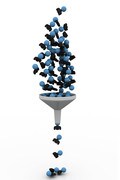News
Taking medication daily may increase the risk of vitamin deficiency
24 June 2011
Daily intake of three or more drugs can be associated with a low status of vitamin D, K, and the B-vitamins in the elderly, a new Austrian study suggests.
01 June 2011
Observations from epidemiological studies on the protective effect of antioxidant micronutrients in relation to cardiovascular diseases warranted an attempt to prove the hypothesis by means of intervention studies. However, the results of many randomized controlled studies were disappointing: many investigations revealed few, if any, differences between groups receiving placebo and those receiving food supplements with vitamin C and/or E and beta-carotene in regard to the risk of developing cardiovascular disease, a benefit was found in only a few groups.
 However, critical analysis of these studies showed that almost all study participants already had adequate supplies of antioxidant micronutrients and an additional intake did not provide any further health benefit. Furthermore, many of the study participants had existing health problems which meant that the antioxidants had not been properly examined and evaluated for their potential use in primary prevention.
However, critical analysis of these studies showed that almost all study participants already had adequate supplies of antioxidant micronutrients and an additional intake did not provide any further health benefit. Furthermore, many of the study participants had existing health problems which meant that the antioxidants had not been properly examined and evaluated for their potential use in primary prevention.
 Outcomes of intervention studies
Outcomes of intervention studies
Most of the large randomized controlled studies that have attempted to prevent the onset of chronic diseases like cardiovascular disease through the administration of antioxidant micronutrients revealed no uniform, significant risk reduction among study participants. However, since participants in most of these studies already had adequate supplies of micronutrients like vitamins C and E as well as beta-carotene, the studies merely confirmed that consuming amounts of micronutrients over and above the recommended intakes brings no additional benefits for the general population.
Moreover, in the randomized controlled studies the participants selected usually had a health problem already. As a rule, it proved impossible to substantiate the hope of preventing further exacerbation of chronic diseases through an intervention with antioxidant micronutrients.
Whereas in an earlier intervention study (1) of patients with a previous history of coronary heart problems it was possible to reduce the number of further infarctions by administration of large doses of vitamin E, neither the Heart Outcomes Prevention Evaluation Study (HOPE) nor the Heart Protection Study (HPS) showed a risk reduction for cardiovascular disease with large doses of vitamin E or a combination of vitamins E, C and beta-carotene (2, 3). For the SU.VI.Max-Study conducted in France, 13,017 participants received either a combination of 120 mg vitamin C, 30 mg vitamin E, 6 mg beta-carotene, 100 μg selenium and 20 mg zinc or placebo for a period of 7.5 years (4). While a reduction in all-cause mortality was observed for the men, no such results were found for the women. The authors suspected that the lower baseline plasma levels of antioxidant micronutrients measured in male participants could be at least partly responsible for the divergence in study outcomes. In the Antioxidant Supplementation in Atherosclerosis Prevention (ASAP) study 520 men and women, smokers and non-smokers received either 180 mg of vitamin E, 500 mg of vitamin C or a combination of both vitamins or placebo for a period of 3 years (5). While neither the vitamin E nor the vitamin C group revealed any effect, in the combination group the progress of carotid atherosclerosis was slowed considerably. In the Italian GISSI Study (6) patients who had already been treated for myocardial infarction were given 300 mg of vitamin E or 1 g of omega-3 fatty acids (PUFA), a combination of the two or a placebo in addition to their usual medication. Deaths due to cardiovascular events were significantly reduced in the PUFA group in the subsequent 3.5 years. In contrast, in the vitamin E group only sudden death was reduced, by 35 percent. Between 1992 and 2004, 39,876 healthy American women aged over 45 were included in the 10-year Women’s Health Study (7). They were given either 600 IU (400 mg) vitamin E every second day or placebo or aspirin. Cardiovascular deaths were reduced by 24 percent in the vitamin E group, while in the over-65 group a 26 percent reduction in cardiovascular disease was found. Unfortunately, participants’ plasma levels were not measured in this study; it was merely mentioned that 38.4 percent of the women in the placebo group had taken a multivitamin preparation.
 Meta-analyses
Meta-analyses
Recently several studies that dealt with the possible benefits of antioxidant micronutrients have been analyzed within the context of meta-analyses. This has led to sometimes contradictory and inconsistent results causing misunderstandings and confusion when intervention studies with different designs and criteria were analyzed jointly. Attempts have been made to reach a conclusive judgment as to the benefits of targeted antioxidant administration in the form of a definitive answer (“effective”, “not effective”, or even “harmful”). Just like individual studies, meta-analyses must be critically reviewed and their results subjected to scrutiny. Indeed, a meta-analysis is only as good as the studies it deals with. So if, for example, the collected studies are too different with regard to content, methodology or objective, or if the selection of studies is biased, this can lead to serious distortion of outcomes and to false conclusions.
Many attempts to reach clear conclusions by meta-analysis of inconclusive randomized controlled studies of antioxidants have broadly failed. Examples are the meta-analyses of Miller et al. (10) and Bjelakovic et al. (11) which did not stand up to in-depth critical scrutiny of the applied methodology by Gerss et al. (12) and Biesalski et al. (13). After Bjelakovic and colleagues published their meta-analysis (11) in January 2007, in which they claimed to have found evidence of increased mortality after supplementation with antioxidants, critical voices were raised: The evaluated studies differed fundamentally in essential points and the overall analysis revealed no statistically confirmed differences with regard to the mortality of study participants receiving antioxidant treatment and those not receiving treatment. Detailed examination of the meta-analysis resulted in many points of criticism (13):
In their summary the authors confirmed that in studies the administration of antioxidants can only show health-promoting effects if the participants’ intake is inadequate. However, if the subjects already have an adequate supply, they will not experience any additional health benefits.
24 June 2011
Daily intake of three or more drugs can be associated with a low status of vitamin D, K, and the B-vitamins in the elderly, a new Austrian study suggests.
15 August 2012
Vitamin D deficiency is common among patients admitted to pediatric intensive care units (PICUs) and is associated with more severe illness, two recent studies from the US and Canada have revealed.
9 January 2015
According to a new study from Germany, an increase in blood vitamin D concentration seems to decrease the odds of having molar-incisor hypomineralization.